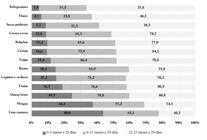Abstract
The scope of this paper was to identify patterns of food consumption and associated factors among children under two years of age in Brazil. It involved a cross-sectional, population-based study using data from the National Health Survey conducted in 2013. Food consumption was measured by dichotomous questions, listing the food ingested solely on the day prior to the interview. The patterns were identified through principal component analysis. Poisson regression was used to obtain a crude and adjusted prevalence ratio. The sample design effect was considered in the analyses that were stratified according to age. Among the 5,052 children, three patterns were identified, being defined as: a “healthy food consumption pattern,” a “milk consumption pattern” and an “unhealthy food consumption pattern.” There was an association between the patterns in each age group, mainly related to skin color, gender, schooling of the head of the family, area of residence and region. A quarter of the children from 12 to 23 months consumed soft drinks, more than a third drank artificial juices and almost half ate candies the day before the interview. Three dietary patterns were identified, besides observing early food ingestion among children under six months of age.
Key words:
Dietary habits; Eating behavior; Children; Principal component analysis

 Food consumption patterns in children under two years of age in Brazil: National Health Survey, 2013
Food consumption patterns in children under two years of age in Brazil: National Health Survey, 2013 Thumbnail
Thumbnail
